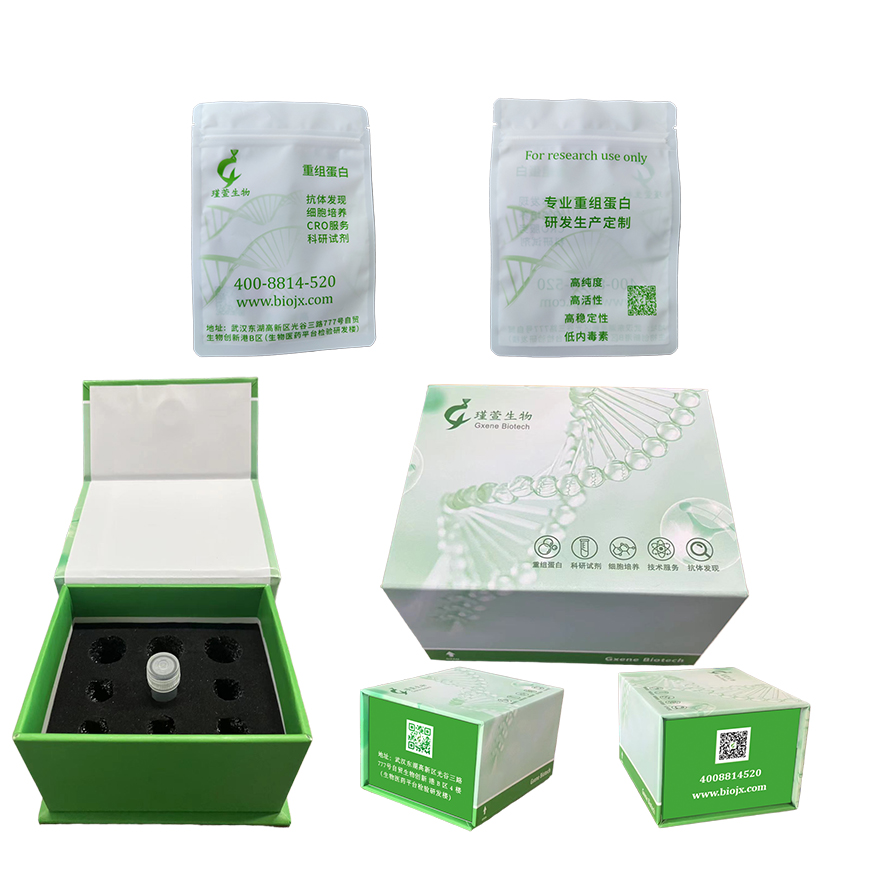研究方向
色素上皮衍生因子属于丝氨酸蛋白酶抑制剂 (serpin) 家族。色素上皮衍生因子基因包含典型的信号肽序列、起始甲硫氨酸密码子和聚腺苷酸化信号,并且与丝氨酸蛋白酶抑制剂超家族其他成员的大小相匹配。色素上皮衍生因子是一种神经营养剂。它在人类胎儿和成人组织中广泛表达,但其表达随着年龄的增长和恶性组织而降低。色素上皮衍生因子的主要抗癌活性源自其双重作用,即间接作用于肿瘤微环境(间接抗肿瘤作用)或直接作用于肿瘤本身(直接抗肿瘤作用)。色素上皮衍生因子具有复杂的神经营养、神经保护、抗血管生成、抗氧化和抗炎特性,有可能被用作治疗糖尿病血管并发症的治疗选择。
种属
Human
表达宿主
Baculovirus-Infected Sf9 Cells
Calculated MW
44.38 kDa
Observed MW
45 kDa
标签
No tag
纯度
> 97% by SDS-PAGE.
内毒素
< 1.0 EU/μg of the protein by LAL method.
制剂
Lyophilized from a 0.22 μm filtered solution of PBS, pH 7.4.Contact us for customized product form or formulation.
描述
Recombinant Human Serpin F1/PEDF Protein is produced by insect cell-baculovirus expression system. The target protein is expressed with sequence (Gln20-Pro418) of human Serpin F1 (Accession #NP_002606.3).
储存
Store at -20℃.Store the lyophilized protein at -20℃ to -80 ℃ up to 1 year from the date of receipt.
After reconstitution, the protein solution is stable at -20℃ for 3 months, at 2-8℃ for up to 1 week.未开盖的干粉蛋白在 -20°C至-80°C可保存12个月;
复溶之后,蛋白溶液在-20°C及以下可保存3个月,在2-8℃可保存1周。
After reconstitution, the protein solution is stable at -20℃ for 3 months, at 2-8℃ for up to 1 week.未开盖的干粉蛋白在 -20°C至-80°C可保存12个月;
复溶之后,蛋白溶液在-20°C及以下可保存3个月,在2-8℃可保存1周。
复溶
Centrifuge the vial before opening. Reconstitute to a concentration of 0.1-0.5 mg/mL in sterile distilled water. Avoid vortex or vigorously pipetting the protein. For long term storage, it is recommended to add a carrier protein or stablizer (e.g. 0.1% BSA, 5% HSA, 10% FBS or 5% Trehalose), and aliquot the reconstituted protein solution to minimize free-thaw cycles.收到重组蛋白产品之后请检查蛋白冻干粉末是否贴于瓶底,如果粉末浮起,开盖之前请先低温离心。将蛋白用说明书中指定的缓冲液复溶至0.1-0.5 mg/mL(请注意蛋白复溶浓度不能低于0.1 mg/mL),室温平衡5-10 min保证充分溶解,复溶过程中请不要剧烈涡旋及吹打蛋白溶液。如需长期储存,建议复溶时添加载体蛋白或者稳定剂(如0.1% BSA, 5% HSA, 10% FBS 或者 5% 海藻糖),同时将复溶后的蛋白溶液按照需求进行分装,储存于-20°C至-80°C,随取随用,避免反复冻融。
背景信息
The protein is a member of the serpin family, although it does not display the serine protease inhibitory activity shown by many of the other serpin family members. The encoded protein is secreted and strongly inhibits angiogenesis. In addition, this protein is a neurotrophic factor involved in neuronal differentiation in retinoblastoma cells.

